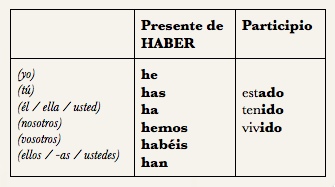To talk about past experiences in an undefined time in the past, whether we don’t know exactly “when”, or just because it’s not important, we use the “Pretérito Perfecto de Indicativo” (Present Perfect).
The pretérito Perfecto in Spanish is the tense used to talk about the recent past.
However, it is important to note that this tense is not used in every speaking country. It is more common in Spain and less common in Latin America.
Formation
The Pretérito Perfecto is formed in the same way as English, with the verb “haber” (is the auxiliar verb, like “to have” in English) and the participle. The auxiliary verb is conjugated for the subject of the sentece:
Example:
– Pedro ha pagado las facturas.
Pedro has paid the bills.
– Ellas no han ido de vacaciones todavía.
They haven’t gone on holidays yet.
The participle is formed by dropping the infinitive ending and adding either -ado o -ido. The participle is invariable, it doesn’t change. We can’t put anything between the auxiliar verb and the participle:
Example:
– Yo ya he aprendido a contar en alemán. And not: Yo he ya aprendido a contar en alemán.
I have already learned to count in german.
Uses
- The pretérito perfecto is frequently used for past actions that continue into the present or continue to affect in the present.
– Mis amigos y yo hemos ido al cine esta semana a ver la última película de George Clooney.
My friends and I, we have gone to the cinema this week to watch the last movie by George Clooney.– He perdido las llaves y no puedo entrar en casa.
I have lost my keys and I can’t get into the house. - The pretérito perfecto is used sometimes with frequency expressions, like: todavía no, aún no, ya, una vez, dos veces, muchas veces, pocas veces…
– Mi novio ha venido a visitarme a Córcega muchas veces.
My boyfriend has come to visit me in Corsica a lot of times.
– Todavía no he aprendido a comunicarme en árabe con mis amigos marroquís, tengo que practicar más.
I haven’t learnt yet to communicate in Arabic with my Moroccan friends, I have to practice more.
Video Class in Spanish
In the video below I explain the Pretérito Perfecto Indicative in Spanish, so you can watch and practise your Spanish listening skills too.



